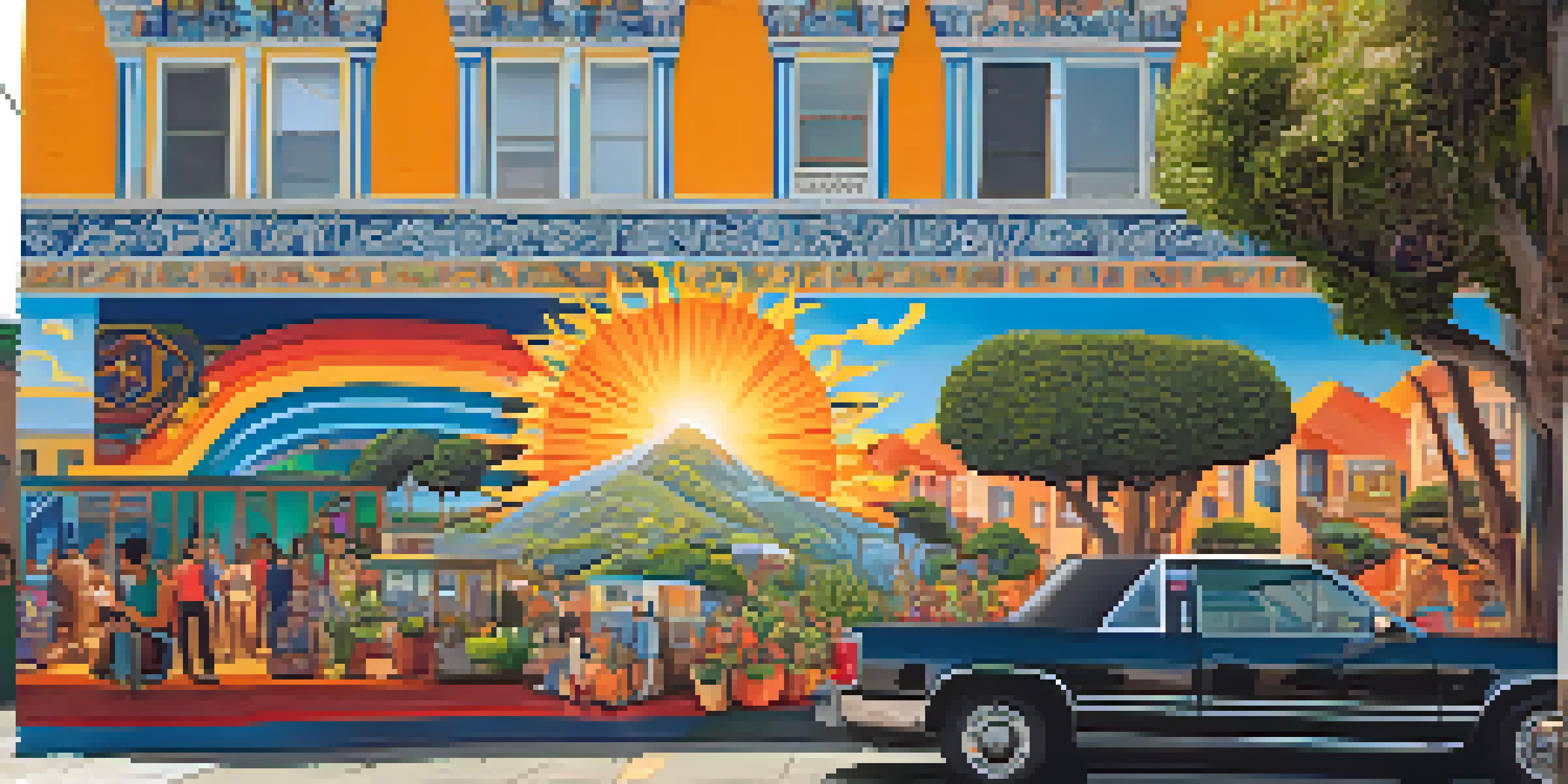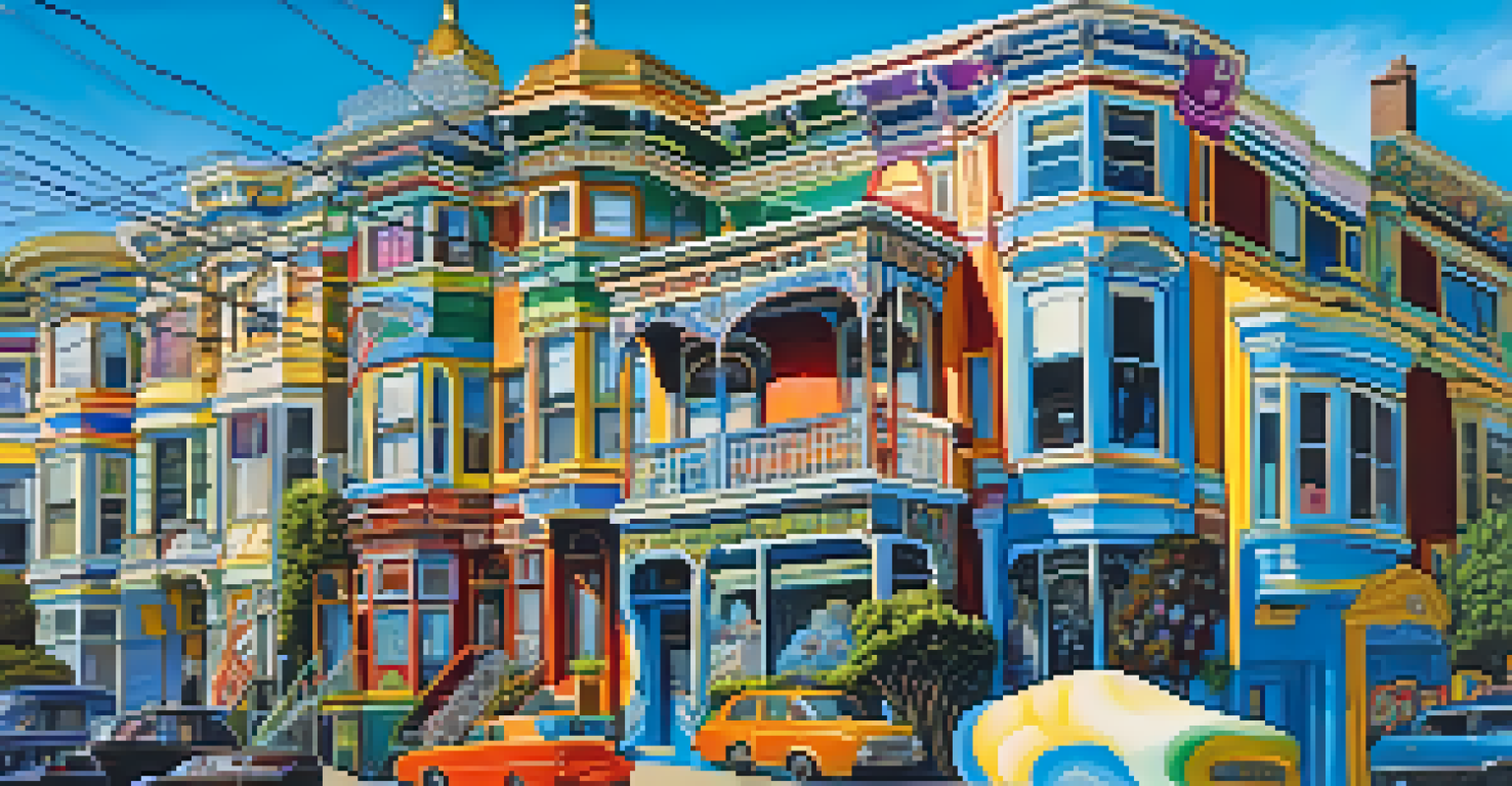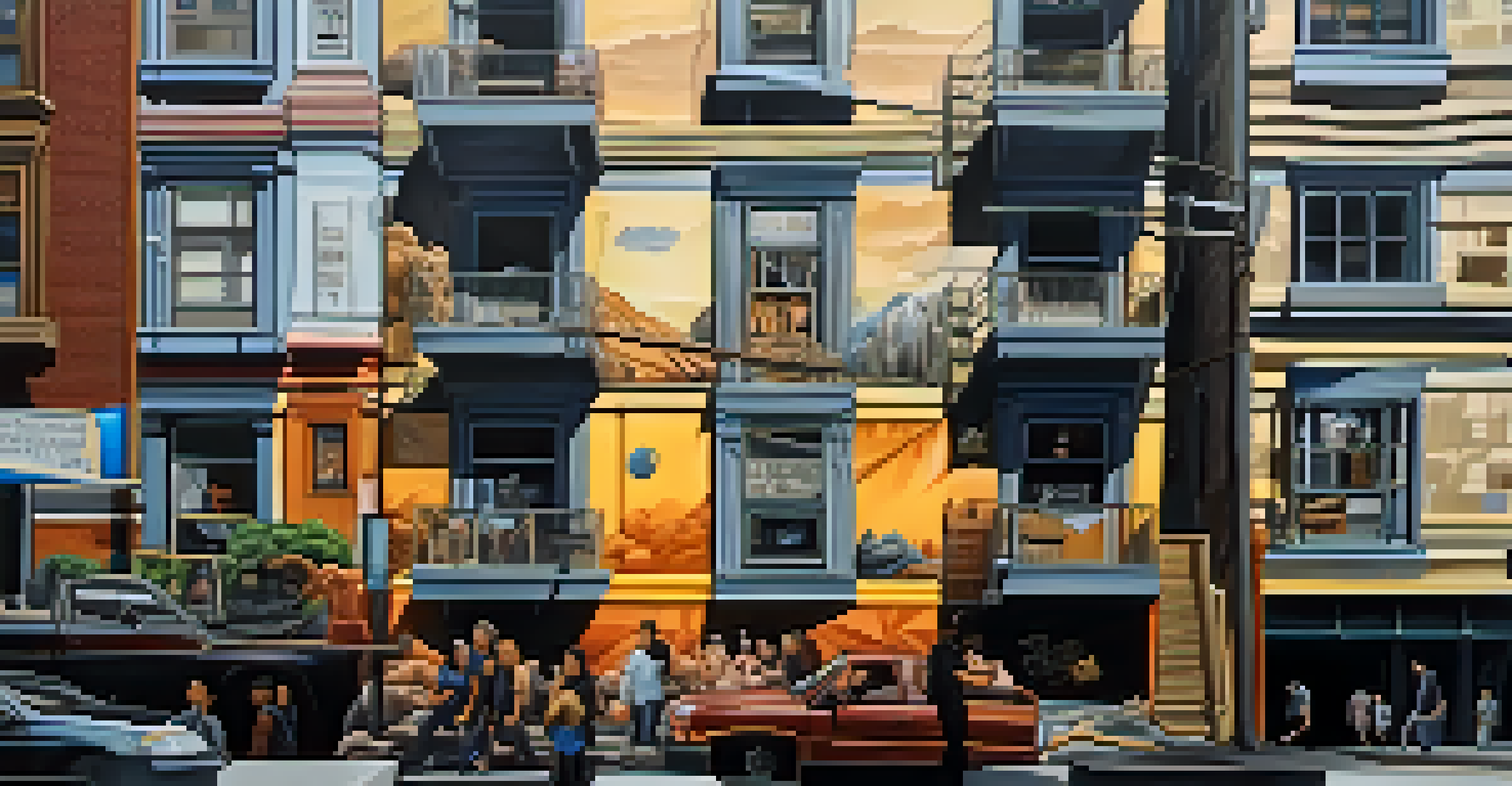Street Art in San Francisco: A Colorful Urban Canvas Explored

The Rise of Street Art in San Francisco
San Francisco's street art scene has evolved dramatically over the years, blossoming from simple graffiti into a dynamic form of artistic expression. This transformation mirrors the city's rich cultural history and diverse communities, making it a unique canvas for artists. Today, murals and installations can be found in nearly every neighborhood, showcasing a blend of styles and messages that reflect the city's spirit.
Street art is a form of expression that can change the way we think about the world around us.
In the 1980s, artists like Barry McGee and Margaret Kilgallen began pushing the boundaries of urban art, turning forgotten spaces into vibrant storytelling areas. Their work paved the way for a new generation of artists who use public spaces to communicate social issues and personal narratives. As these artists gained recognition, the city embraced street art as an integral part of its cultural fabric.
Now, street art is not just tolerated but celebrated in San Francisco, with initiatives like the San Francisco Arts Commission promoting public murals. Festivals such as the Mission Mural Festival highlight the importance of these vibrant expressions, bringing together artists and the community to engage in creative dialogue. This ongoing support has solidified street art's role in the city, making it a must-see attraction for locals and tourists alike.
Iconic Neighborhoods for Street Art Lovers
When it comes to street art in San Francisco, certain neighborhoods stand out as must-visit spots. The Mission District, in particular, is famous for its colorful murals that adorn buildings and alleyways, reflecting the area's rich Latino culture. Walking through Balmy Alley, visitors can admire works that address social justice, immigration, and community pride, making each mural a powerful statement.

Another neighborhood to explore is the Haight-Ashbury, known for its vibrant history tied to the 1960s counterculture movement. Here, you'll find walls bursting with psychedelic colors and themes that pay homage to peace, love, and artistic freedom. The street art in this area not only captures the essence of the era but also continues to inspire new generations of artists.
Street Art as Cultural Expression
San Francisco's street art has evolved into a vital form of cultural expression, reflecting the city's diverse communities and social issues.
Lastly, the Tenderloin district offers a different perspective on street art, with pieces that often highlight the struggles of urban life. This area serves as a canvas for artists who want to provoke thought and conversation, making it a poignant experience for viewers. Each neighborhood showcases the diverse narratives and emotions that street art can convey, inviting exploration and appreciation.
Street Art Festivals and Events
San Francisco hosts a variety of street art festivals that celebrate creativity and community engagement. One of the most notable is the Mission Mural Festival, which brings together local and international artists to create new works and participate in workshops. This event not only beautifies the neighborhood but also fosters connections between artists and residents.
Art should comfort the disturbed and disturb the comfortable.
Another exciting event is the 1AM Gallery's annual Street Art Festival, which features live mural painting, art exhibitions, and interactive activities. This festival attracts art lovers from all over, creating an energetic atmosphere where creativity thrives. Workshops during the event encourage attendees to try their hand at street art, promoting a hands-on appreciation for the craft.
These festivals are more than just celebrations of art; they serve as platforms for dialogue and community building. By engaging with local artists and exploring their processes, participants gain insight into the stories behind the artwork. Ultimately, these events help to strengthen the bond between art and the community, ensuring that street art remains an essential part of San Francisco's identity.
The Role of Technology in Street Art
In the digital age, technology has significantly influenced the world of street art. Artists are now using social media platforms like Instagram to showcase their work, reach broader audiences, and connect with fellow creatives. This online presence has transformed the way street art is perceived, allowing for instant sharing and engagement with viewers around the globe.
Additionally, technology has made it easier for artists to experiment with new techniques and mediums. For instance, some artists incorporate augmented reality (AR) into their murals, creating immersive experiences for viewers. By simply scanning a mural with a smartphone, spectators can access digital content that enhances their understanding of the artwork and the artist's message.
Neighborhoods Showcase Unique Art
Iconic neighborhoods like the Mission District and Haight-Ashbury feature murals that tell powerful stories and celebrate local culture.
Moreover, technology has also played a role in preserving street art. With the rise of digital archiving, many artists document their work online, ensuring that even if a mural is painted over, the memory remains. This blend of traditional art forms with technology highlights the adaptability and resilience of street art in a rapidly changing urban landscape.
Social and Political Commentary in Street Art
Street art in San Francisco often serves as a powerful medium for social and political commentary. Artists use their work to address pressing issues such as homelessness, racial inequality, and environmental concerns, making their messages resonate deeply within the community. This form of expression not only raises awareness but also inspires action among viewers.
For example, murals highlighting the plight of the homeless population can be found in several neighborhoods, prompting conversations about homelessness in the city. These artworks challenge passersby to reflect on their own perspectives and consider ways to contribute to solutions. By embedding social messages into their art, creators play a crucial role in advocating for change.
Furthermore, street art can also be a tool for empowerment, giving a voice to marginalized communities. Many artists collaborate with local organizations to amplify the stories of those often overlooked. Through vibrant visuals and impactful messages, street art becomes a source of hope and resilience, fostering a sense of unity and purpose in the face of adversity.
The Impact of Street Art on Local Businesses
Street art has not only transformed the urban landscape but also positively impacted local businesses in San Francisco. Many establishments have embraced the movement by commissioning murals to enhance their storefronts, creating visually appealing spaces that attract customers. This symbiotic relationship between businesses and artists has contributed to a thriving local economy.
Moreover, areas with vibrant street art often see an increase in foot traffic, benefiting nearby shops and restaurants. Tourists and locals alike flock to these neighborhoods, eager to explore the art while supporting local commerce. As a result, the presence of street art has become a valuable asset for businesses looking to stand out in a competitive market.
Community Engagement Through Festivals
Street art festivals in San Francisco foster community engagement and dialogue, connecting artists with residents and enhancing cultural appreciation.
Additionally, local artists receive increased visibility through these collaborations, allowing them to gain recognition and grow their careers. This mutually beneficial dynamic fosters a sense of community, with businesses becoming champions of local talent. Ultimately, street art enriches both the cultural and economic landscape of San Francisco.
Preserving the Future of Street Art
As street art continues to evolve, conversations about its preservation are becoming increasingly important. Many murals are at risk of being painted over or neglected, sparking debates on how to protect these valuable pieces of cultural heritage. Community initiatives and organizations are stepping up to advocate for the preservation of iconic works, ensuring that future generations can appreciate them.
One approach to preservation involves establishing legal murals and designated street art zones, where artists can freely express themselves without fear of censorship. By creating spaces where street art is celebrated, cities can foster a vibrant artistic community while maintaining the integrity of the art form. This also allows for ongoing dialogue about the significance of street art in urban environments.

Furthermore, as technology advances, digital archiving is becoming a tool for preserving street art history. By documenting murals and their stories, artists can ensure that their work lives on even if the physical piece is lost. This combination of community engagement, legal support, and technological innovation will play a crucial role in safeguarding the future of street art in San Francisco and beyond.